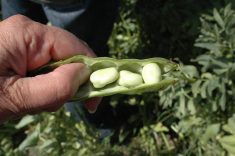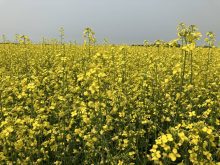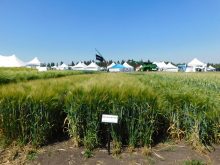Wet soils are a problem we don’t usually deal with in this area. “It’s a really different year for us.”
DON PITTMAN
WARNER FARMER
Southern Alberta farmers never say they have too much moisture, but this year, quite a few are biting their tongues.
At time of writing last Monday, most farmers had all of their land seeded, but it’s been a struggle, especially for bean growers, who barely finished seeding by June 11. Their crop insurance deadline was extended to June 17, giving most time to finish seeding. Some opted to seed beans where they could and seed low spots to barley when those dry up.
Read Also

New crop insurer policy enables easier startup for faba beans
Agriculture Financial Services Corporation updated its normals for faba beans, which may open the door for more Canadian producers to feel comfortable growing the pulse crop in the future.
George Lubberts of Complete Agronomic Services in Nobleford took an optimistic view of delayed seeding this spring.
“You really haven’t missed anything because we haven’t had any growing weather,” he said. “Even though we’re well into the second week of June, we’ve had almost no heat units. Dryland canola is looking good and cereals are okay – they don’t mind cool wet conditions. And, the winter crops look excellent.”
However, much less winter wheat than normal was seeded last fall. Don Pittman, based in Warner, agreed it would be nice to have twice as much winter wheat this year. “It’s nice to have some land seeded the season before the spring,” he said. “And, it’s overwintered fine. Excess moisture hasn’t been a problem.”
Crops seeded in the first part of May have mostly emerged well and look to be off to a good start with lots of potential. Peas and lentils look especially good.
However, crops seeded in the third week of May went into wet ground that’s become wetter. “Wet soils are a problem we don’t usually deal with in this area,” Pittman said. “It’s a really different year for us.”
He said there has been leaching and denitrification, especially from early-seeded land. As heavier soils have dried, they’ve crusted so farmers are trying to decide whether or not to reseed, but it’s too wet to decide. On the positive side, late seeding provided a jump on weed control. Preseed burnoff has been later than usual, so weeds that are usually more competitive and yield-robbing, such as wild oats, have been better controlled.
Cool and late
A lot of crop was seeded in May, said Gerald Anderson, an Agri-Trends agronomy coach based in Coaldale. That’s late for irrigated land. As everywhere, canola and cereals look much better than beets, which are really struggling – they need warmth.
Anderson says nutrients have been leached down below the reach of roots that are growing slowly because soils are so cold. He’s recommending foliar applications of N and/or sulphur to help crops through this temporary shortage.
All the agronomists expected leaf diseases to show up later, but so far hadn’t seen a lot of problems. So far it had been too cold for flea beetles to do much damage.
Lubberts said he had seen lots of cool-weather weeds like wild oats, kochia and volunteer canola. Pittman said he’d seen some fields with gopher populations like he’d never seen before. Some canola fields have virtually no canola left.
Cold, wet weather should put a dent in grasshopper numbers. Pittman said he hadn’t seen any hatchlings before the last rains.
The agronomists have all seen signs of pea leaf weevil and cabbage seedpod weevils. Gordon Parker at Medicine Hat found buffalo beans covered in weevils, but wasn’t certain whether they were cabbage seedpod weevils on yellow flowers or pea leaf weevil on a wild relative of peas.














